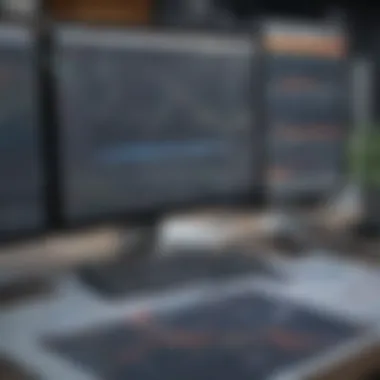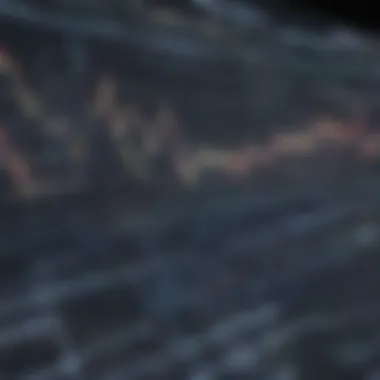Essential Free Software for Elliott Wave Charting


Intro
In the dynamic world of trading, adapting to market movements is crucial. One methodology that has captured the attention of traders is the Elliott Wave Theory. Understanding market behavior through waves can help identify potential trends and reversals. This guide explores the realm of free Elliott Wave charting software, which allows traders and investors to analyze price movements and make insightful decisions.
Using such software can be pivotal for both novices and seasoned traders. By grasping the essentials of Elliott Wave Theory, one can unlock a new perspective on market analysis. This guide is structured to provide a thorough understanding, beginning with key terminologies that are essential for navigating this domain.
"In trading, the trend is your friend until the end."
As we move forward, we will illuminate the pros and cons of different software options, practical tips for maximizing their utility, and common pitfalls to avoid in your trading journey. Each section seeks to equip you with the necessary knowledge to turn data into decisions.
Intro to Elliott Wave Theory
In the world of trading, understanding market movements is crucial. Elliott Wave Theory serves as one significant framework for interpreting these movements. Developed by Ralph Nelson Elliott in the 1930s, this theory posits that market prices move in recurring cycles, driven by investor psychology, which in turn reflects collective behavior. As you dive deeper into this guide, you'll see the relevance of Elliott Wave Theory not just as a tool, but as a foundational concept for many investors today.
Historical Background
Ralph Nelson Elliott, a humble accountant, noticed patterns in stock market prices during the Great Depression. He proposed that market movements followed specific wave patterns, which he classified into five upward waves and three downward waves. This discovery was revolutionary, offering insight into what seemed like chaotic market behavior. Elliott's work was documented in his book, The Wave Principle, and it laid the groundwork for technical analysis in trading.
Decades later, Elliott Wave Theory has turned into a fundamental cornerstone for many traders and investors. With the evolution of technology and access to data, the practical application of this theory has grown, allowing a broader audience to engage with it effectively.
Core Principles of Elliott Wave Theory
Elliott's principle is predicated on two fundamental ideas: the structure of the waves and the rhythmic nature of market cycles.
- Wave Structure: Elliott identified that waves occur in a specific pattern. The upward trend comprises five distinct waves (1, 2, 3, 4, and 5), while the downward trend is characterized by three waves (A, B, and C). This wave structure creates a fractal nature, meaning that waves appear within waves across different time frames.
- Fibonacci Relationships: Another core principle stems from the Fibonacci sequence, often woven into financial analysis. Elliott found that waves tend to relate to one another in Fibonacci ratios. For instance, if wave one is 100 units long, wave three might be 162 units (approximately 1.618 times wave one).
"The market is a reflection of financial sentiment, echoed through the rhythmic patterns of investor behavior."
Understanding the basic mechanics of this theory is essential for grasping how to effectively use Elliott Wave charting software. When charting software integrates these fundamental principles, it empowers users to forecast potential market movements, dramatically shifting their approach to trading.
Importance of Charting Software in Trading
In the realm of trading, charting software proves to be a cornerstone for making informed decisions. It allows traders to visualize data and identify patterns, enhancing their trading strategies. The dynamic world of financial markets can be overwhelming—sometimes feeling like you’re trying to find a needle in a haystack. This is where charting software becomes invaluable.
Traders, both novice and seasoned, benefit from a suite of tools that helps dissect market movements. Accurate graphs and charts assist in understanding price fluctuations over time, enabling traders to spot trends and reversals. Without such tools, traders could feel lost, relying solely on gut feelings and minute-by-minute news. Trusting intuition alone can often lead to costly miscalculations.
Enhancing Analytical Capabilities
Charting software stands as a vital tool for enhancing analytical capabilities. It allows users to interpret vast amounts of data swiftly and accurately. A well-equipped platform includes technical indicators such as Moving Averages, Relative Strength Index (RSI), and Bollinger Bands, each giving insights into market conditions.
For instance, an investor employing the Fibonacci Retracement tool can swiftly gauge potential support and resistance levels, enhancing their decision-making process:
- Technical indicators illuminate market directions by analyzing historical prices.
- Reinforcement of patterns assists in predicting future price movements.
- Data overlays help in simplifying complex market scenarios.
By utilizing these tools, traders can clarify complex price movements and increase their confidence in executing trades.
Increasing Efficiency in Trade Analysis
Time is indeed money in trading, and efficiency is paramount. Charting software enhances this efficiency through real-time data updates. The ability to track multiple instruments and markets simultaneously means less time spent searching for information and more time making informed trades.
Additionally, users can customize alerts for specific conditions—such as when a stock hits a certain price or a technical indicator crosses a threshold. This proactive approach:
- Reduces reaction times during volatile market conditions.
- Facilitates quicker decision-making, mitigating the risk of missing opportunities.
- Supports automated trading, allowing execution of precisely defined strategies without emotional intervention.


In summary, the integration of charting software in trading not only enriches analytical capabilities but also streamlines the analysis process, transforming how traders approach the markets. As a trader becomes adept at utilizing these tools, they build a nuanced understanding of price movements which is crucial for successful trading.
Advantages of Utilizing Free Elliott Wave Charting Software
Elliott Wave Theory has become a core element in predicting market behavior, and the utilization of charting software can make this process much smoother for traders. The advantages of using free Elliott Wave charting software are multifaceted and have drawn attention from a wide range of investors. This section delves into two pivotal benefits: cost-effectiveness and accessibility for all levels of investors, both of which hold significant appeal.
Cost-Effectiveness
One of the primary draws of free Elliott Wave charting software is undeniably its cost-effectiveness. In a market where penny saved is a penny earned, the idea of obtaining tools without breaking the bank is certainly attractive. By using free software, traders can sidestep subscription fees or hefty upfront costs typically associated with premium platforms.
This affordability enables both seasoned professionals and novices to equip themselves with necessary analytical tools without financial strain. The savings garnered from using free charting tools can be redirected towards actual trading, educational resources, or other investments that bolster trading acumen.
- Budget-Friendly: No need to allocate significant portions of your budget to software.
- Resource Allocation: Save money, allowing for more financial freedom to explore other resources.
- Trial Periods: Many paid platforms offer limited trials, making free software a valid option during initial exploration.
An often-overlooked benefit is that opting for free software may sometimes lead you to discover platforms that offer competitive features, allowing you to compare functionalities before committing to any paid solutions. You just might find an open-source gem that fulfills your charting needs without the strings attached.
Accessibility for All Levels of Investors
As the saying goes, every cloud has a silver lining. In the context of free Elliott Wave charting software, this struggle provides a golden opportunity for investors at any experience level. The beauty of free tools is their ability to democratize access to sophisticated market analysis. Whether you're a seasoned trader or a greenhorn just starting out, these resources can elevate your trading wisdom.
- User-Friendly Interfaces: Many free platforms have put emphasis on intuitive design, which means even those who aren't tech-savvy can navigate through the software with relative ease.
- Educational Resources: Some free charting software come bundled with tutorials and guidelines, which prove invaluable for those looking to strengthen their understanding of Elliott Wave Theory.
Free software also encourages experimentation among investors, allowing them to try various approaches without worrying about financial repercussions. This creates a learning environment where users can practice their skills, refine their strategies, and gradually build confidence in their trading decisions. The idea that practice makes perfect rings especially true in trading, and free tools pave the way for continuous improvement.
"The growth of free resources has altered the trading landscape, allowing more individuals the chance to engage meaningfully with market strategies."
Key Features to Look For in Charting Software
When diving into the world of Elliott Wave charting software, it's crucial to understand the specific features that can elevate your trading experience. Picking the right software isn't just about what looks good visually; it’s about the functionality and usability that can support your trading decisions. Navigating through various platforms, one should focus on aspects that enhance user experience, analytical capabilities, and customization preferences. Let's break down a few key features you really shouldn't overlook.
User Interface Design
First impressions matter in any realm, and a clean, intuitive user interface design can make or break your trading routine. An effective interface is more than just eye candy; it directly influences your efficiency as a trader. A well-structured layout with easily navigable tabs and menus can keep your focus sharp. Look for software that allows you to customize your workspace. Can you rearrange the charts to your liking? Are the tools you need just a click away? A cluttered interface can cause confusion, so it’s vital to have a clear design that supports quick decision-making.
"The smoother your navigation through the software, the more time you can spend analyzing and less time hunting for features."
Integration of Analytical Tools
A standout feature of proficient charting software is its integration with various analytical tools. Whether you are using Fibonacci retracement, candlestick patterns, or indicators like RSI, ensure your charting software can handle these tools seamlessly. Tools that provide real-time data and adaptive analytics can take your market evaluation to new heights. You want to be able to switch between different analyses without jumping through hoops. Check if the platform allows you to overlay multiple analytical tools. This enables a more rounded view of market movements, enhancing your forecasting accuracy.
Customization Options
Lastly, don't underestimate the power of customization. Every trader has unique needs and preferences, so having a software that adapts to those requirements is important. Look for features that allow you to adjust settings such as color schemes, chart types, and templates. A familiar environment reduces cognitive load and can lead to better trading performance.
Moreover, the ability to save customized layouts can save significant time. When trading conditions shift rapidly, having your preferred settings at your fingertips can be a game-changer.
Comparing Free Elliott Wave Charting Software Options
When diving into the world of financial trading, particularly with Elliott Wave Theory, having access to reliable charting software is akin to a sailor having a sturdy compass. Finding the right tools can significantly sway your ability to analyze markets and make informed decisions. Thus, comparing free Elliott Wave charting software options is not just useful; it’s essential for every trader looking to gain an edge.
The value of comparing these tools lies in understanding the various features they offer. Each platform has its own set of strengths and nab weaknesses, making it critical to scrutinize them before settling on one. These comparisons help uncover what best suits your trading style and analytical needs. You'll want to ensure that the software you choose aligns with your specific goals, whether you are a novice just starting to scratch the surface or a seasoned trader navigating complex market structures.
Review of Popular Free Platforms
In the realm of free Elliott Wave software, several platforms stand out, each providing unique functionalities:


- Wave57: This platform offers a user-friendly interface with tools to draw and annotate waves effectively. It caters to both beginners and advanced traders.
- TradingView: Known for its robust community features, it allows traders to access shared charts and insights, which can be beneficial for honing one's analytical skills.
- MetaTrader 4 and MetaTrader 5: These platforms are widely used for trading in Forex markets, offering comprehensive charting tools and the ability to implement Elliott Wave theories directly.
Each of these platforms has carved out its niche in this competitive space. The availability of features such as historical data analysis or real-time data feeds greatly facilitates the application of Elliott Wave principles.
Strengths and Weaknesses of Each Software
While choosing your charting software, it’s critical to evaluate both the strengths and weaknesses of your options. Understanding these factors helps in making an informed decision.
- Wave57
Strengths:Weaknesses: - TradingView
Strengths:Weaknesses: - MetaTrader 4/5
Strengths:Weaknesses:
- Intuitive design that caters to all levels of users
- Dedicated tools for Elliott Wave analysis
- Limited integration with other financial databases
- May not offer extensive back-testing capabilities
- Excellent for community engagement and sharing strategies
- Provides an array of scripts and add-ons for enhanced functionalities
- Some features may require a paid subscription for full utilization
- Steeper learning curve for newcomers
- Highly optimized for Forex trading
- Comprehensive support for automated trading strategies
- More complex interface can be overwhelming for beginners
- Requires installation and setup, which could deter casual users
By weighing these factors, you equip yourself not just with software, but with a supportive tool that enhances your market analysis and trading strategies.
How to Effectively Use Charting Software
Using charting software efficiently can make all the difference in a trader's decision-making process. Particularly with Elliott Wave Theory, the right tools can enhance understanding and provide insights that might be missed when reading charts by hand. Mastery of the software can lead to more informed and timely trading actions, enabling investors to capitalize on market movements more effectively.
Setting Up and Customizing the Software
Setting up your charting software might seem straightforward, but a thoughtful approach can yield great benefits. Begin by downloading your chosen platform, be it MetaTrader, TradingView, or others that people often mention in forums on reddit.com or facebook.com.
Once installed, dive into the settings. Customize the workspace to fit how you think and react when trading. You can adjust the color schemes to avoid eye strain or opt for grid lines to help visualize your charts better. Many of these platforms allow for various time frames, so be sure to set these according to your trading style—day trading, swing trading, or long-term investing. A clear setup provides clarity while analyzing raw data.
Additionally, explore the built-in features like moving averages and volumes. It’s also wise to connect social trading features if available; they can provide valuable insights from other traders’ analyses, sharpening your own interpretations
Interpreting Elliott Wave Patterns
Once you’re comfortable with the software’s layout, the next step is to interpret Elliott Wave patterns. On the screen, the most pronounced waves stand out and often signify potential trends. Understanding the fundamental structure is critical. Each wave has its own characteristics, so recognize these should be your guiding light.
Key patterns to focus on include:
- Impulse Waves: Often move with the trend in five steps.
- Corrective Waves: These move against the trend and typically occur in three steps.
The subtle nuances in wave patterns could indicate potential reversals or continuations in the market. Regularly practice identifying these patterns on your charts.
Furthermore, it can be advantageous to convert your chart elements into your own language. Instead of simply labeling cycles as ‘Wave 1,’ think of it in context—what economic conditions led to that movement? Such considerations deepen your comprehension, allowing you to see beyond the surface.
"Knowing the theory isn’t enough; knowing how to actively engage with it through effective software use is where the real power lies."
Combining these interpretations with other analytical tools available in your software will undoubtedly enhance your effectiveness as a trader. Stay mindful, keep learning, and adjust as needed. This way, you’ll not only use the software but also grow alongside it.
Common Mistakes to Avoid with Charting Software


Using Elliott Wave charting software can significantly enhance your trading experience, but there are pitfalls that many fall into. Knowing these common mistakes can save time, effort, and potentially a substantial amount of money.
Overreliance on Technology
In today’s fast-paced trading environment, it's tempting to lean on technology as a crutch. While charting software can provide quick analyses and visual insights, putting all your eggs in the digital basket can lead to problems. Relying solely on these tools may make traders blind to the nuances of market conditions.
For instance, a trader may see a clear wave pattern on a chart generated by their software and proceed to make decisions. However, this might not account for market sentiment, geopolitical events, or unexpected news that can cause markets to react unpredictably. The software can be a guide, but it should not dictate every decision. It's vital to combine technological insights with qualitative information—what’s happening in the world can’t be overlooked.
Ignoring Market Context
Context is king—this was true long before trading software came along, and it remains essential today. Many traders using Elliott Wave charting software can become so focused on the patterns revealed by the software that they neglect the broader market environment.
For example, consider a trader who spots a bullish wave pattern in their chart but fails to recognize that a significant economic announcement is on the horizon. If the news turns out to be unfavorable, even a strong technical signal can get completely overturned.
This oversight can be likened to reading a map without considering the terrain. You could have the best path figured out, but if a river appears, your plans need to change. Therefore, staying updated with financial news and understanding the bigger picture is key.
"Using charting software without understanding the market context is like sailing without checking the weather. You might reach your destination, but the journey may be perilous."
By being aware of these common pitfalls, traders can better navigate the complex world of Elliott Wave analysis and use their charting tools more effectively, ensuring they do not fall prey to avoidable errors.
The Future of Charting Software in Trading
Charting software has become a mainstay in the world of trading. As markets evolve rapidly, the need for software that adapts and grows is even more paramount. In this section, we look at what's on the horizon for charting tools, particularly those that focus on Elliott Wave analysis. With technology paving new pathways, traders might find themselves equipped with an even stronger arsenal to base their decisions on. The upcoming trends and enhancements will not only streamline workflows but also enrich the trading experience for all types of investors.
Advancements in Software Features
As technology continues to leap forward, so does the feature set of charting software. In the coming years, one can expect a heftier emphasis on intuitive user interfaces that reduce the learning curve. For instance, many developers are incorporating drag-and-drop functionalities for chart customization, allowing users to modify layouts and add technical indicators with ease.
- Enhanced data visualization will also take center stage. More sophisticated graphical representations will help traders spot patterns at a glance, making it easier to act swiftly in fast-paced environments.
- Moreover, comprehensive backtesting capabilities are poised to become standard. Users will be able to simulate their trading strategies over historical data, refining their methods before risking actual capital.
- Lastly, cross-platform compatibility is also noteworthy. With the rise of mobile trading, being able to sync chart data between devices ensures traders stay connected no matter where they are.
Integration of Artificial Intelligence
Artificial intelligence has infiltrated various sectors, and trading is no exception. The integration of AI into charting software is becoming a game changer for investors looking to break ground in data analysis. Think of AI as a smart assistant that learns from past behaviors and optimizes future trading strategies.
This is how AI can enhance charting software:
- Predictive Analytics: AI can analyze past market movements and make predictions about future price changes, giving traders an edge when deciding their entry and exit points.
- Sentiment Analysis: Some platforms are starting to employ machine learning algorithms to read news and social media trends, gauging market sentiment toward specific assets. This, in combination with Elliott Wave Theory, allows for a more informed analysis.
- Trade Automation: Imagine being able to set up your trading parameters, then letting the software execute trades on your behalf based on predefined criteria. With AI, this is increasingly attainable, freeing traders from the relentless monitoring of charts.
In summary, the future of charting software is looking bright and full of innovation. By focusing on advancements in features and integrating AI, developers are working to make trading not just easier, but also more effective for a diverse range of users.
"As technology evolves, so too must the tools we use for trading. Embracing the future can bring about unparalleled opportunities for smart investing."
Final Thoughts on Free Elliott Wave Charting Software
When it comes to making informed trading decisions, the right tools make all the difference. This article has explored various aspects of free Elliott Wave charting software, from core principles to practical applications. In the end, the significance of these tools cannot be overstated. They serve as the bridge between complex market theory and user-friendly analysis, enabling traders to visualize trends and make strategic choices.
Assessing Your Needs
Every trader is unique, and understanding your specific needs is crucial before choosing a charting software. Consider whether your focus is on short-term trades or long-term investments. For instance, if you lean towards day trading, robust, real-time analysis might take priority. In contrast, long-term investors might value features that allow them to identify major cycles and trends over time.
- Functionality Important to You: Make a list of must-have features. Do you need tools for back-testing strategies or just solid visualizations? Your day-to-day requirements will guide your choice.
- User Experience: Consider the learning curve as some software may come loaded with features that can be overwhelming. Look for an interface that aligns with your comfort level.
- Community and Support: A strong user community and reliable customer support can provide invaluable assistance. Resources like forums can be a treasure trove of knowledge, improving your proficiency.
Emphasizing Continuous Learning
In the world of trading, the only constant is change. New market trends, software updates, and evolving strategies necessitate continuous learning. Embracing this philosophy shortens the gap between theoretical knowledge and effective practice.
- Stay Updated on Market Trends: Enroll in courses or webinars that delve into Elliott Wave Theory and its applications in modern trading. The more you know, the better equipped you become.
- Experiment with Your Software: Don’t shy away from testing different features of your chosen charting software. Practical experience solidifies what you learn and helps you adapt to new market conditions.
- Utilize Online Resources: Leverage platforms such as Wikipedia or specialized forums on Reddit to stay informed about best practices and new methods.
"The market is always changing; smart traders adapt to that, continually learning and evolving."
In summary, free Elliott Wave charting software offers invaluable tools and insights, but realizing their potential hinges on assessing personal needs and committing to continuous learning. By prioritizing these elements, traders can master the waves of the market and navigate with confidence.



